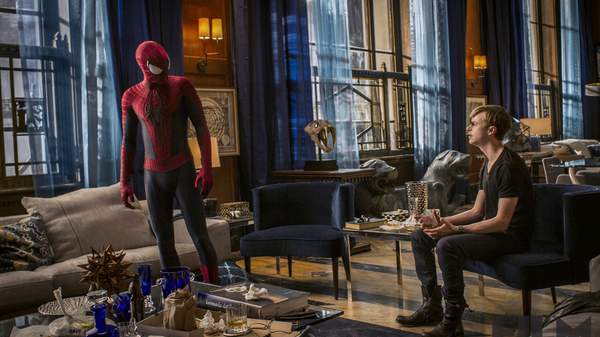Overview
The problem with Spider-Man movies — all Spider-Man movies — can be summed up in one word: villains. With names like 'Green Goblin', Doc Oc', 'Sandman' and now 'Electro', they're just too 'comic booky'. It may seem a ridiculous argument given these are films based on comic books, but consider the Batman model. There, the villains were also possessed of suitably villainous names like: Ra's al Ghul, Scarecrow, Joker, Two-Face and Bane, but they were — without exception — just men. Specifically, a man with a face, a man with a sack over his face, a man with paint on his face, a man with half his face missing and a man with half his face covered in a Dyson vacuum cleaner.
As men, however, mortal and tangible, no matter how outlandish their schemes, they remained believable. Again, it may seem an unfair to invoke plausibility given we're talking here about a franchise built around a man/spider hybrid, but believing in Spidey has never been the problem. We're on board with that. A freak, near-spontaneous mutation definitely pushes the bounds of probability, but it stays just enough inside to feel okay to audiences, helped in no small way by the constant, private and human moments from Peter Parker's life to which we're given backstage passes: the experimentation, the girl troubles, the laundry and even the sniffles.
There has been one outstanding Spider-Man villain — a complex, tormented and conflicted soul with whom Spider-Man has battled constantly throughout every film — the only problem is, it's Spider-Man. Not Topher Grace's 'bad Spidey' from 2007's Spider-Man 3, it's literally Spider-Man. "With great power comes great responsibility" proclaimed Peter's grandmother way back in the original Spider-Man, and that dark concord has been the most compelling dynamic to all the films that followed.
All great superheroes are, in a way, tortured by their abilities, forced to choose between desire and duty. The demons from Peter's choices make his version of the superhero conundrum all the more engrossing, because (causality scepticism aside) they've led to people's deaths. First his grandfather, then his girlfriend's father — the latter's dying wish being that Peter leave his daughter Gwen alone.
For these reasons, of the two concurrent plot lines in The Amazing Spider-Man 2, one is far more appealing than the other. The weaker thread is the 'villain plot', featuring a loner electrical engineer (Jamie Foxx) turned furious spectral Tesla coil by the name of 'Electro'. He's somewhere between a bullied high school kid and an emotional Doctor Manhattan, whose motivations for citywide chaos and suffering are as gossamer as his translucent skin. Ultimately, Electro's only worth to this film is to highlight the choice Peter (Andrew Garfield) must make between the love of his life, Gwen (Emma Stone), and his self-imposed duty to protect the city.
This is the story that makes The Amazing Spider-Man 2 a film well worth watching. In fact, if it were just two hours of Garfield and Stone flirting and quipping with each other, not only would it have possibly been a better movie, it would have smacked down most of the other supposed romantic comedies of the past decade. The real-life couple has an outrageously appealing on-screen chemistry, and their exchanges are so well-written that it's a crime when actual crimes are committed to interrupt them.
The special effects are, of course, spectacular, and the use of 3D is a rare example of the technique adding to, rather than distracting from, the storytelling. The music, too, is excellent, employing a body-shuddering pseudo dubstep whenever Electro crackles into action. But it's the small-scale, romantic moments that shine most brightly, culminating in an ending that'll have you humming 'We have all the time in the world' as you make you way home.
